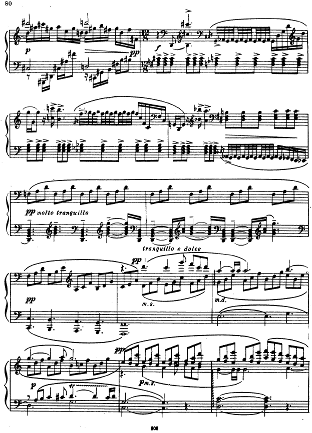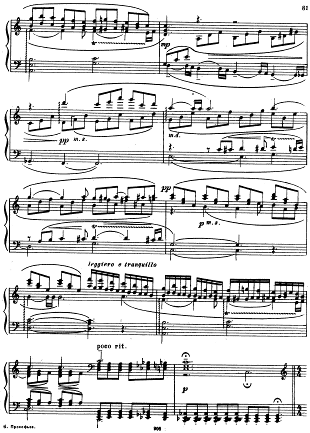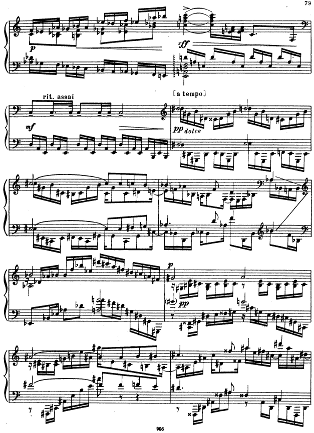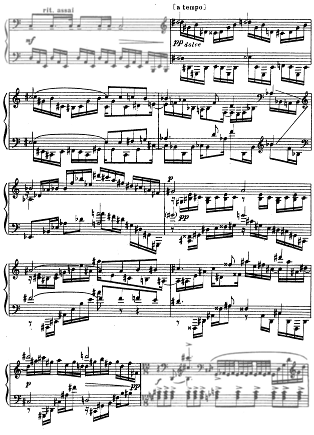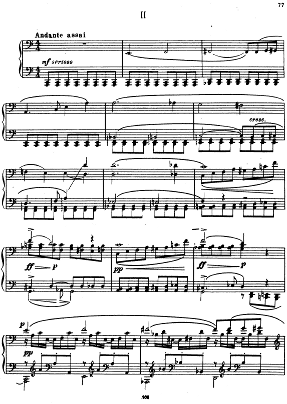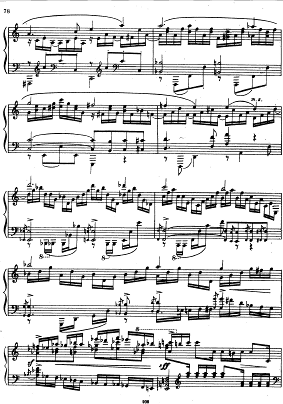August 27, 2010
Prokofiev Piano Sonata No. 4, 2nd movement
The first appearance of the B material, starting at measure 33 and going through 53. Pages four and five below:
I've been referencing Boris Berman's book Prokofiev's Piano Sonatas for performance and analysis tips. He points out that this movement was a favorite of Prokofiev's and Berman draws his performance advice from both an orchestrated version the Prokofiev made (alas, unavailable at IMSLP) and a recording that Prokofiev made in 1935. I recently purchased a CD of all of Prokofiev's piano recordings (along with another CD with those of Debussy), but I've avoided listening to this movement in order to get it in my head better. Though, admittedly, the Nissman recording already dominates my ear.
The B material, ignoring the 6-measure bridge, consists of two 3-measure phrases, repeated and connected by one measure that mimics the last measure of the bridge. (3+3)+1+(3+3). The repeat is a slight variation on the first. The repetition/variation of the 3-measure phrase reminds me of that of the melody in the A section. Technically, this was much easier and is close to performance level now, so much of this week was also spent with the considerably more taxing earlier pages. Next up is the return to the A (which is a near exact repeat of the music just prior), a variation on the B-bridge, and then finally the brilliant closing section that combines both A and B melodies. I've read through it a couple of times, and it's going to be extremely enjoyable once I get it in my hands.
Diaspora
Diaspora (the open source Facebook) launches in two weeks. After learning about Appleseed and several others (listed in my original post), I was less interested in Diaspora. The Best Possible Outcome from all of this, however, would be for these different open source solutions to interoperate by developing a common protocol. I'm sure it's being discussed.
August 22, 2010
The Girl with the Dragon Tattoo; Stieg Larsson
Continue reading "The Girl with the Dragon Tattoo; Stieg Larsson"Scott Pilgrim vs. the World
[ 4/5 | IMDB | Rotten Tomatoes ]
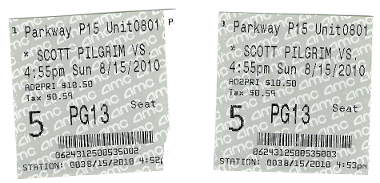
I read the books beforehand on the recommendation of basically everyone on the internet. They were enjoyable, felt directed towards a younger audience, were a little too sweet at times, and yet had some very clever storytelling. Re-readings increased the appreciation. The movie was, simply, fun. Like the books, it veered into sweetness too far for my tastes, but overall the movie has such an energy that you can't dislike it. Although coming in at a weak 5th place its opening weekend, the movie really needed more people actively not disliking it.
There were many nice touches, both from the books and created for the movie. The 8-bit opening logo, the flashy battles, Kim Pine's glib hatred of everything, Comeau's all-knowing chatter in the background, and Wallace Wells scene stealing. The movie was definitely its own creation. There are a few complaints (the final scenes with Scott+Knives+Ramona seemed rushed and insincere) that are ultimately inconsequential when measured against the mania of the film as a whole. It feels a bit like The Fifth Element in this regard. Planning a second viewing.
August 18, 2010
Prokofiev Piano Sonata No. 4, 2nd movement
Beginning to get comfortable with the end of the first repeat of the A section, eight measures from 25 through 32, ending on the first measure of page 4. Page 3 is below:
The overall structure (revising what I had in my first post) is:
- A A-bridge (measures 1-24)
- A B-bridge B (measures 25-53)
- A B-bridge BA (measures 54-88)
I still have a tendency to hear the beginning A of the second section as belonging to the first section, but it is repeated note-for-note in the beginning of the third section and so may be more appropriately viewed in this new structure. The eight measures, crossing two pages, are stitched together in a single image below:
The instances of the A theme as first stated in measures 1-24 were interleaved: successive ones starting before the previous had ended. The instances of the A theme in these eight measures are placed against each other in contrary motion. The first four measures with the bass rising and the soprano falling until they cross; the second four with the upper voice splitting in two from a unison to the final note in measure 32 three octaves apart. Lines first converging and then spreading out. The interleaving in measures 1-24 make me think of different characters entering a scene in a movie or ballet, each talking against the other a la Altman. At measures 25-32, the conversations/dancers are more synchronized.
Technically, these have been the most strenuous and won't be completely comfortable for a while. The B theme will be both a physical respite and an aural one with noticeably less chromaticism.
News stories that echo concerns expressed in The Windup Girl
After reading The Windup Girl earlier this year, I became hyper-aware of stories related to crops and genetic engineering.
- (28 Apr 2009) From Seeds of Suicide to Seeds of Hope: Why Are Indian Farmers Committing Suicide and How Can We Stop This Tragedy? [ via Reddit ] - Indian farmers start using Monsanto seeds and get locked into the need to purchase them instead of relying on seed from their crops. According to the article, Monsantos seeds (though not terminator seeds) have
non-renewable traits.
- (8 Mar 2010) Protecting the Global Food Chain from On Point - The author of the book The Viking in the Wheat Field talks about the debt humanity owes the scientists who protect and enhance the world's seed banks.
- (23 Mar 2010) MRSA: The Drug-Resistant 'Superbug' That Won't Die from Fresh Air - Antibiotic-resistant staph infections on the rise.
- (17 May 2010) Haitian Farmers Commit to Burning Monsanto Hybrid Seeds - Avoiding the forced dependency on multinationals (a la Naomi Klein's Shock Doctrine thesis).
- (7 Jun 2010) Superweeds Threaten U.S. Farms from On Point - Round-up-ready seeds create round-up-resistant weeds. Round-up-ready seeds are those modified to be resistant to round-up and therefore can survive being sprayed while the weeds can't. To add insult to etc., farmers have abandoned the tillers needed for weeding because round-up had obviated the need for them. Now they have neither round-up nor tillers and are going broke(r) paying for day laborers to weed manually.
- (6 Aug 2010) Genetically Modified Canola 'Escapes' Farm Fields [ via Slashdot ] - If we can't control the boundary of GM crops, we can't mitigate unexpected environmental complications (think kudzu X 100). Coming from Slashdot, the discussion slid into the absurdity that a corporation can patent DNA.
August 15, 2010
Some random pics from Scott Pilgrim
Most found randomly around the internets. Others taken from Edgar Wright's daily photo blog...
Continue reading "Some random pics from Scott Pilgrim"August 12, 2010
Prokofiev Piano Sonata No. 4, 2nd movement
I've got the first half of the A section, through measure 21, in my hands now. Here are the first two pages, the last measure of page 2 is measure 22 and the beginning of the A-section bridge:
The chromatic theme is stated several times, beginning on different notes, and overlapping:
- E in measures 2-7 in the right hand
- B-flat in measures 5-9 in the left then right hand
- E in measures 13-18 in the right hand
- B-flat in measures 16-21 from left to right
- E-flat in measures 19-21 in the left hand
This feels like A minor and then G minor in the last statement moving to the bridge. Measures 19-21 were the hairiest so far, but with the parts separated across the keyboard they were also the easiest to make audible sense of. Measures 13-15 (from the last two measures of page 1) are going to be more difficult to make sense of because those descending octave notes (played by the left hand) cut across the melody and accompaniment. At this point in my playing, the different parts in these measures are very muddled.
This evening, I focused primarily on 19-21:
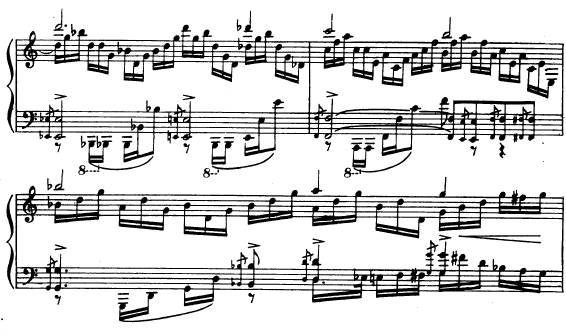
August 11, 2010
Prokofiev Piano Sonata No. 4, 2nd movement
The rest of the month is slated for looking at the 2nd movement of Prokofiev's 4th Piano Sonata. (Edition purchased a few years ago. Two years ago, I had worked on slow movements from two other Sonatas.) I started, slowly, a week or so ago but will be spending time every day for the rest of the month to see how far I can get.
There's a public domain score on IMSLP that appears to be the exact same printing as what I'm using (Leeds Music Corp. and Meliott/Melliot Press), so it will be convenient to reference and screencap it for inclusion here. Pages 9 through 16; eight in all.
Form: the A section contains a chromatic theme and runs to the first measure of page 4. The theme is repeated twice with the two instances connected by a three-measure bridge starting at the last measure of page 2. The B section begins with a fanfare-like bridge, then a page-and-a-half of a lyric theme. The A section returns at the top of page 6. At the bottom of that page the B section returns. In the middle of page 7, the lyric B theme returns again, this time with the chromatic A theme overlaid in the bass. Overall: A A-bridge A | B-bridge B A B-bridge B | BA.
August 9, 2010
Yoko Kanno songs compared for plagiarism
I just had to reorder the OST for Ghost in the Shell: Solid State Society (lost the copy that came with my DVD) and so was hanging around YouTube searching for interesting Yoko Kanno videos. yuta84001 over on YouTube has compiled three videos pairing Yoko Kanno songs with those of many other artists that, to a sometimes greater sometimes lesser degree, she appears to have plagiarized. The worst offenders are clearly stolen melody, harmony, and arrangement. Others less so but with various flourishes--a sampled vocal or guitar lick--that are unmistakably thieved. Here're the vids:
A video response was made in her defense that is so laughable I won't dignify it with a link. Similarly, the YT comments attempting to defend her appear primarily from musically uneducated fanboys. A more appropriate explanation might be to treat her work as what it is: musical illustration. The best visual illustrators are masters of all genres and virtuoso technicians. Illustrators' works may take from classic designs and repurpose them. In the history of music, such thieving is much more common. YouTube contains a veritable cottage industry of claims of plagiarism between various bands. Most are pretty innocuous similarities based on stylistic short hand markings of strum patterns, chord progressions, and arrangement. Kanno is a skilled and prolific workhorse of anime soundtracks. Her swiping is pretty blatant at times, but as a percent of overall output I'm not sure it should be much of an issue.
August 7, 2010
Movie week, day 5: Kids
[ 4/5 | IMDB | Rotten Tomatoes ]
Almost 15 years to the day after it was released, I finally get to see this film. I went to see Korine's Trash Humpers at The Plaza a week or so ago and got obsessed with seeing and re-seeing his other films. TH was beautiful and brutal. One review compared it favorably to Lynch's latter-day flicks Mulholland Dr. and Inland Empire w/r/t their destruction of cinematic narrative. I saw an influence of Jean Dubuffet's Art Brut in its raw, unprocessed expression. Lisa and I went to a preview of The High's Dali exhibit last night, and I couldn't help but think that his (and the other Surrealists') Freudian confessions were nothing compared to the self-revelation of art of the last few decades. (Insert any insights about reality TV here.)
I can't believe I didn't list Gummo as one of my top 10 films. I had/have it on VHS and it has stayed with me aesthetically. After seeing TH, I ordered Gummo, Kids (18-year-old Korine as writer), and Julien Donkey-Boy on DVD. But tonight was Kids: a 16yo revels in his conquest of sub-14yo virgins. A previous virgin--Chloe Sevigny (hers and Rosaio Dawson's first film)--finds she's HIV+ from him (her only partner) and seeks him out to stop any further infection. He's got his eye on a friend's young sister, and so the movie becomes a dual race for sex and redemption. Kids ended up being more casually shocking than I expected and similarly more artful in its shock. Although I can't recommend this to any female, I'm curious about fidelity in the early scenes with the girls talking about sex. I can confirm that the early guy scenes were true enough, if a bit more explicit and, well, brutal.
August 5, 2010
Movie week, day 4: The Ghost Writer
[ 4/5 | IMDB | Rotten Tomatoes ]
Ewan McGregor gets hired to finish ghost writing ex-Prime Minister Pierce Brosnan's memoirs after the previous writer is found dead from an apparent drunken drowning. The chaos of an unhappy household--containing wife and mistress--gets more complicated as the PM gets thrown under the wheels of The Hague's International Criminal Court. Did you know that the United States (and their pals China, Iraq, Israel, Libya, Qatar, and Yemen) voted against joining the ICC? Anyway, by staying in the US, Pierce Brosnan saves his ass from being prosecuted. There was one spoiler-tastic misstep, I felt, but overall the movie was a ripping good Polanski yarn.
Movie week, day 3: Below
[ 3/5 | IMDB | Rotten Tomatoes ]
American submarine on the run from German battleships in WWII picks up British survivors of a destroyed hospital ship. After that, bad luck follows the submarine as accusations and hallucinations afflict the crew and guests. Around 10 minutes in, I realized that I had already seen part of this movie years ago but forgotten. Oops. It was long enough ago to make me forget the ending until we got there, so it was still a new-ish experience. Good suspense in a constrained physical space that reminded me, maybe unfairly, of Pitch Black, also directed and written by David Twohy. Second of three writers was Darren Aronofsky.
August 3, 2010
Movie week, day 2: Terribly Happy
[ 4/5 | IMDB | Rotten Tomatoes ]
Danish noir. Feels like Fargo or Blood Simple (or that Australian movie The Square we watched a few months back at the Atlanta Film Festival). Disgraced cop gets relocated from the big city--Copenhagen--to a small town that immediately begins testing his sanity. Very well done! Nicely constructed and it keeps you on your toes. The director has quite a few flicks under his belt, so it might be worth checking out his other works.
August 2, 2010
Movie week, day 1: Visioneers
[ 3/5 | IMDB | Rotten Tomatoes ]
I don't recommend this too highly but it was enjoyable enough, flaws and all. It's a predictable if surreal anti-corporate saga with strains of Office Space, Brazil, and 1984. The strangeness was too uneven and insincere at times to be successful, yet with a couple of redeemingly unexpected moments.
